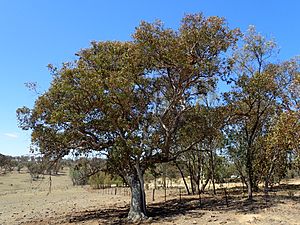Northern blue box facts for kids
Quick facts for kids Northern blue box |
|
|---|---|
 |
|
| Eucalyptus magnificata near Hillgrove | |
| Scientific classification | |
| Genus: |
Eucalyptus
|
| Species: |
magnificata
|
The Northern Blue Box, also known as Eucalyptus magnificata, is a special kind of tree or a small, bushy plant called a mallee. It only grows in a small part of New South Wales, Australia. This tree has rough bark on its trunk and bigger branches, but smooth bark higher up. It has broad, egg-shaped leaves, and its flowers are usually white or pale yellow. After the flowers, it grows cone-shaped fruits.
Contents
What the Northern Blue Box Looks Like
The Northern Blue Box is a tree or a mallee that usually grows to be about 8 to 15 meters tall. That's like a building that's two to four stories high! It has a special woody swelling at its base called a lignotuber, which helps it regrow after fires.
Its bark is rough and flaky on the trunk and bigger branches, but smooth and greyish higher up. Young plants and new shoots (called coppice regrowth) have egg-shaped or round leaves. These leaves are about 3.5 to 8 centimeters long and 3.5 to 6.5 centimeters wide.
Adult leaves are broad and shaped like a spear or an egg. They are the same shade of green on both sides, about 5 to 15 centimeters long and 3 to 6.5 centimeters wide. They narrow down to a stalk called a petiole, which is about 1 to 3 centimeters long.
The flower buds grow in groups of seven. They can be found where the leaves meet the stem, or at the end of branches. Sometimes they grow on a branching stalk called a peduncle, which is about 7 to 13 millimeters long. Each individual bud has a small stalk called a pedicel, about 1 to 4 millimeters long.
Mature buds are oval-shaped and sometimes have a whitish, powdery coating (this is called glaucous). They are about 5 millimeters long and 3 to 5 millimeters wide. Each bud has a cone-shaped or beaked cap, called an operculum, that covers the flower parts.
This tree flowers in June and November. Its flowers are white, pale yellow, or lemon-colored. After flowering, the fruit grows into a woody, cone-shaped capsule. These capsules are about 5 to 9 millimeters long and wide. Inside, the seed-holding parts (called valves) are tucked below a thin rim.
How it was Named
The Eucalyptus magnificata was officially described in 1990 by two botanists, Lawrie Johnson and Ken Hill. They studied a sample collected by Richard Hind Cambage near Uralla way back in 1917.
The second part of its scientific name, magnificata, comes from a Latin word meaning "magnified" or "made larger." This name was chosen because its leaves, buds, and fruit are bigger than those of other similar eucalypt trees.
Where it Lives
The Northern Blue Box grows in grassy woodlands. It prefers shallow soils near Armidale in New South Wales and Stanthorpe in south-eastern Queensland.
Protecting the Northern Blue Box
This special eucalypt tree is considered "endangered." This means there are not many of them left, and they are at risk of disappearing. The New South Wales Government has laws, like the Biodiversity Conservation Act 2016, to help protect it.
Images for kids




